Es war länger ruhig, aber es gibt Nachschub - und zwar was fast schon SF-mäßiges...

1:72 SAAB OAS 41 'Víðarr'; aircraft "23 Grey" of Skaraborgs Flygflottilj F 7, Swedish Air Force; Satenäs AB, 2014 (Whif/kit conversion) by
dizzyfugu, on Flickr
1:72 SAAB OAS 41 'Víðarr'; aircraft "23 Grey" of Skaraborgs Flygflottilj F 7, Swedish Air Force; Satenäs AB, 2014 (Whif/kit conversion)[/url] by
dizzyfugu, on Flickr
Some background:The Víðarr (or Vidar, "Wide ruler", a Nordic god among the Æsir associated with vengeance) or officially SAAB OAS 41 is Sweden's first manned aircraft with stealth technology, and the first aircraft of its kind in Europe in operational service.
"OAS" is an abbreviation of the aircraft's primary tactical roles: "Osynlig Attack Spaning", "Unseen attack and reconnaissance missions". Much of the OAS 41's technology and elements were developed and tested on unmanned vehicles, namely SAAB's SHARC and FILUR demonstrators.
 1:72 SAAB OAS 41 'Víðarr'; aircraft "23 Grey" of Skaraborgs Flygflottilj F 7, Swedish Air Force; Satenäs AB, 2014 (Whif/kit conversion) by dizzyfugu, on Flickr
1:72 SAAB OAS 41 'Víðarr'; aircraft "23 Grey" of Skaraborgs Flygflottilj F 7, Swedish Air Force; Satenäs AB, 2014 (Whif/kit conversion) by dizzyfugu, on Flickr
 1:72 SAAB OAS 41 'Víðarr'; aircraft "23 Grey" of Skaraborgs Flygflottilj F 7, Swedish Air Force; Satenäs AB, 2014 (Whif/kit conversion) by dizzyfugu, on Flickr
1:72 SAAB OAS 41 'Víðarr'; aircraft "23 Grey" of Skaraborgs Flygflottilj F 7, Swedish Air Force; Satenäs AB, 2014 (Whif/kit conversion) by dizzyfugu, on Flickr
SHARC (Swedish Highly Advanced Research Configuration) was an experimental unmanned aerial vehicle (UAV) built by Saab AB. Since the late 90-ies SAAB had been carrying out preliminary studies about several Unmanned Aerial Vehicles (UAV) concepts but not taking them into flying demonstrators.
In 2001 it was decided to start the SHARC Technology Demonstrator (SHARC TD) project.
Because of a limited budget and good in-house experiences from flight tests of instrumented sub-scale aircraft, it was decided that the SHARC TD should be in 1:4 scale of the original SHARC design. One of the major goals of the project was to test the airworthiness process for a military UAV or aircraft of similar layout, and this could well be achieved even with sub scaled aircraft. Even the goal of testing a lean development process for demonstrators could be achieved in that way.
The SHARC TD project was initiated in 2001 with first flight less than one year later, on February 11th 2002, with the basic version. The more advanced version made its maiden flight on April 9th 2003, less than two years after project start.
 1:72 SAAB OAS 41 'Víðarr'; aircraft "23 Grey" of Skaraborgs Flygflottilj F 7, Swedish Air Force; Satenäs AB, 2014 (Whif/kit conversion) by dizzyfugu, on Flickr
1:72 SAAB OAS 41 'Víðarr'; aircraft "23 Grey" of Skaraborgs Flygflottilj F 7, Swedish Air Force; Satenäs AB, 2014 (Whif/kit conversion) by dizzyfugu, on Flickr
 1:72 SAAB OAS 41 'Víðarr'; aircraft "23 Grey" of Skaraborgs Flygflottilj F 7, Swedish Air Force; Satenäs AB, 2014 (Whif/kit conversion) by dizzyfugu, on Flickr
1:72 SAAB OAS 41 'Víðarr'; aircraft "23 Grey" of Skaraborgs Flygflottilj F 7, Swedish Air Force; Satenäs AB, 2014 (Whif/kit conversion) by dizzyfugu, on Flickr
In September 2003 the SHARC flew a number of missions out of visual range, ranging around 20 km from the control station location. In January 2004 the effort towards the development of the ATOL functionalities was initiated, and led to a successful flight test campaign in August 2004, during which fully autonomous mission were demonstrated, from standstill to standstill.
The SHARC system was composed by two flying demonstrators (BS-001 and -002), a GCS and some GSE for engine start and cooling air supply on ground. The SHARC TD is a 60 kg jet-engine driven aircraft. The airframe was manufactured in light-weight composite materials; the airframe weighed only 8 kg (without landing gear).
 1:72 SAAB OAS 41 'Víðarr'; aircraft "23 Grey" of Skaraborgs Flygflottilj F 7, Swedish Air Force; Satenäs AB, 2014 (Whif/kit conversion) by dizzyfugu, on Flickr
1:72 SAAB OAS 41 'Víðarr'; aircraft "23 Grey" of Skaraborgs Flygflottilj F 7, Swedish Air Force; Satenäs AB, 2014 (Whif/kit conversion) by dizzyfugu, on Flickr
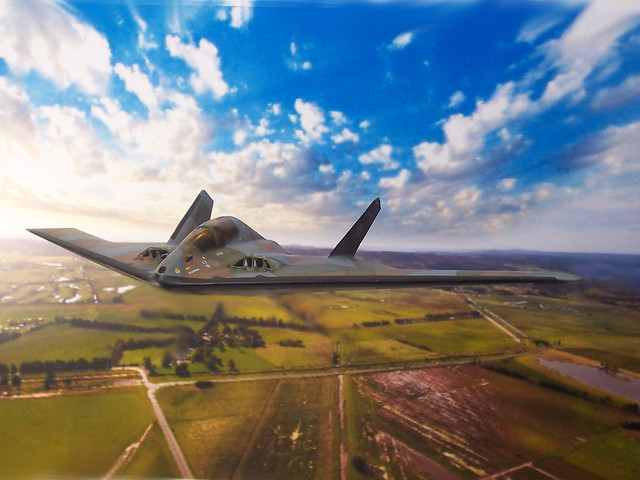 1:72 SAAB OAS 41 'Víðarr'; aircraft "23 Grey" of Skaraborgs Flygflottilj F 7, Swedish Air Force; Satenäs AB, 2014 (Whif/kit conversion) by dizzyfugu, on Flickr
1:72 SAAB OAS 41 'Víðarr'; aircraft "23 Grey" of Skaraborgs Flygflottilj F 7, Swedish Air Force; Satenäs AB, 2014 (Whif/kit conversion) by dizzyfugu, on Flickr
The payload consisted of a forward looking colour video camera. The avionic system (hardware and software) was designed and manufactured by SAAB and is based on Flight Test Instrumentation system COMET 15 used in the Gripen and Viggen fighter a/c.
Before the decision to develop an in house avionic system, a market survey was conduced, but no existing system had been fulfilling specifications. Electro-optic fibres, or “fly-by-light”, were used to the actuators in order to minimize the risk for Electro Magnetic Interference.
Saab and FMV’s technology demonstrator program FILUR made its first flight in 2006. FILUR’s main objective was to show the tactical importance of stealth technology applied on aerial vehicles, to gain experience and to set a foundation for stealth requirements for future aerial systems and air-surveillance systems.
The focus with the FILUR program was on low signature, for both radar and IR-signature. “Static measurements of radar cross section (RCS) made late 2004 showed really good performance and corresponded with calculated data. In flight measurements of stealth performance will be done as a next step”, said Jan Boström FILUR Project Manager, Saab Aerosystems.
 1:72 SAAB OAS 41 'Víðarr'; aircraft "23 Grey" of Skaraborgs Flygflottilj F 7, Swedish Air Force; Satenäs AB, 2014 (Whif/kit conversion) by dizzyfugu, on Flickr
1:72 SAAB OAS 41 'Víðarr'; aircraft "23 Grey" of Skaraborgs Flygflottilj F 7, Swedish Air Force; Satenäs AB, 2014 (Whif/kit conversion) by dizzyfugu, on Flickr
 1:72 SAAB OAS 41 'Víðarr'; aircraft "23 Grey" of Skaraborgs Flygflottilj F 7, Swedish Air Force; Satenäs AB, 2014 (Whif/kit conversion) by dizzyfugu, on Flickr
1:72 SAAB OAS 41 'Víðarr'; aircraft "23 Grey" of Skaraborgs Flygflottilj F 7, Swedish Air Force; Satenäs AB, 2014 (Whif/kit conversion) by dizzyfugu, on Flickr
The technology developed in FILUR would be used for future Saab systems, being UAVs or manned aircraft, which became the OAS 41 which had been under development since 2004.
The SAAB OAS 41 made its maiden flight in 2012, and in early 2014 a pre-production batch of five aircraft has been assigned to Skaraborgs Flygflottilj ("Skaraborg Air Force Wing") F 7 in Satenäs, where the aircraft are operated alongside JAS 39 Gripen multi-purpose fighters for evaluation and integration.
Conceptually the OAS 41 is very similar to the much earlier US-American F-117, dedicated to ground attacks with precision weapons, attacks against coastal/sea targets and reconnaissance missions.
All ordnance or equipment is carried internally in a large bay which is covered by sliding doors. Typical weapons include up to three Rb 75 (AGM-65 Maverick) missiles, two GBU-12 laser-guided smart bombs or two AGM 119 "Penguin" anti-ship missiles. Iron or cluster bombs as well as pods with unguided missiles are also an option.
 1:72 SAAB OAS 41 'Víðarr'; aircraft "23 Grey" of Skaraborgs Flygflottilj F 7, Swedish Air Force; Satenäs AB, 2014 (Whif/kit conversion) by dizzyfugu, on Flickr
1:72 SAAB OAS 41 'Víðarr'; aircraft "23 Grey" of Skaraborgs Flygflottilj F 7, Swedish Air Force; Satenäs AB, 2014 (Whif/kit conversion) by dizzyfugu, on Flickr
Beyond that, the aircraft can also carry air-to-air missiles like the actice radar RB 99 (AIM-129 AMRAAM) or the IR-guided Rb 74 (AIM-9L Sidewinder), up to four of each.
The OAS 41 does not feature an internal gun, even though up to two podded Mauser BK 27 cannons can be carried internally. Overall, its range of weapons is highly identical to what the JAS 39 Gripen can deploy.
Alternatively to offensive loads, the OAS 41 can carry camera of sensor pallets in its belly, making it highly adaptable.
 1:72 SAAB OAS 41 'Víðarr'; aircraft "23 Grey" of Skaraborgs Flygflottilj F 7, Swedish Air Force; Satenäs AB, 2014 (Whif/kit conversion) by dizzyfugu, on Flickr
1:72 SAAB OAS 41 'Víðarr'; aircraft "23 Grey" of Skaraborgs Flygflottilj F 7, Swedish Air Force; Satenäs AB, 2014 (Whif/kit conversion) by dizzyfugu, on Flickr
 1:72 SAAB OAS 41 'Víðarr'; aircraft "23 Grey" of Skaraborgs Flygflottilj F 7, Swedish Air Force; Satenäs AB, 2014 (Whif/kit conversion) by dizzyfugu, on Flickr
1:72 SAAB OAS 41 'Víðarr'; aircraft "23 Grey" of Skaraborgs Flygflottilj F 7, Swedish Air Force; Satenäs AB, 2014 (Whif/kit conversion) by dizzyfugu, on Flickr
It is uncertain how many aircraft wil actually be built, since the Swedish Air Force officially announced that the OAS 41 is not to replace its JAS 39 fleet, rather complement it or take over exclusive missions due to its stealth features. The type's limited performance will probably confine to a limited scope of missions, and with the running cost reductions it is not expected that more than 30 OAS 41's will ever leave the production line for the Swedish Air Force, unless it would be exported and follow in the Gripen's footsteps, but this remains doubtful.
General characteristics:Crew: 1
Length: 6.70 m (21 ft 11 in)
Wingspan: 18,29 m (59 ft 11 in)
Height: 3,96 m (13 ft)
Wing area: ~68 m² (729 ft²)
Empty weight: 6.739 kg (14.844 lb)
Internal fuel: 2.500 l
Max. takeoff weight: 13.600 kg (29,760 lb)
Powerplant:2× Svenska Flygmotor RM13S turbofans (General Electric CF34-3S), with 4.150 each
Performance:Maximum speed: 692 mph (1.115 km/h) at height
Cruise speed: Mach 0.7
Landing speed: 210 km/h
Range: 4.828 km (3.000 mi) with internal fuel
Service ceiling: 13.381 m (43.830 ft)
Rate of climb: 60 m/s (11.811 ft/min)
Armament:Up to 3.000 kg of ordnance, all carried in a ventral bomb bay, including air-to-ground and air-to-air missile, smart and iron bombs, gun and rocket pods, ECM equipment and pallets with cameras and sensors for reconnaissance missions.
Das Ding ist eine Scale-o-rama-B-2 von Dragon in 1:200, die aber stark modifiziert wurde:
- Cockpit einer X-32 von Revell
- Haube einer F/A-18B, umgedreht
- Seitenruder (gekappt) von einer F-117
- Neues Fahrwerk aus Teilen der X-32 und F-117
- Vergrößerter Waffenschacht mit zwei GBU-12
- Veränderte Triebwerksauslässe
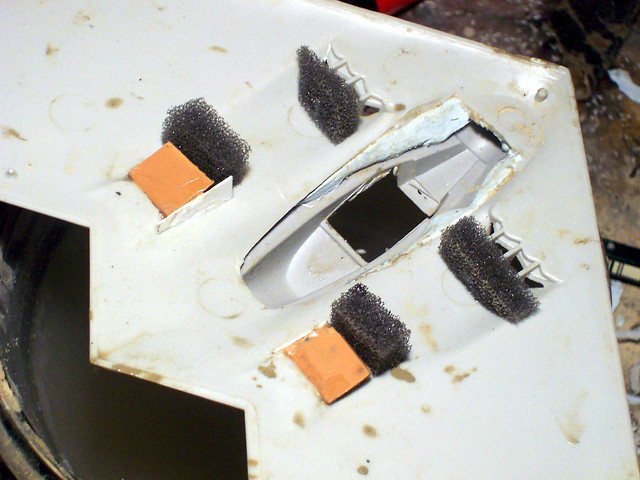
1:72 SAAB OAS 41 'Víðarr'; aircraft "23 Grey" of Skaraborgs Flygflottilj F 7, Swedish Air Force; Satenäs AB, 2014 (Whif/kit conversion) - WiP by
dizzyfugu, on Flickr
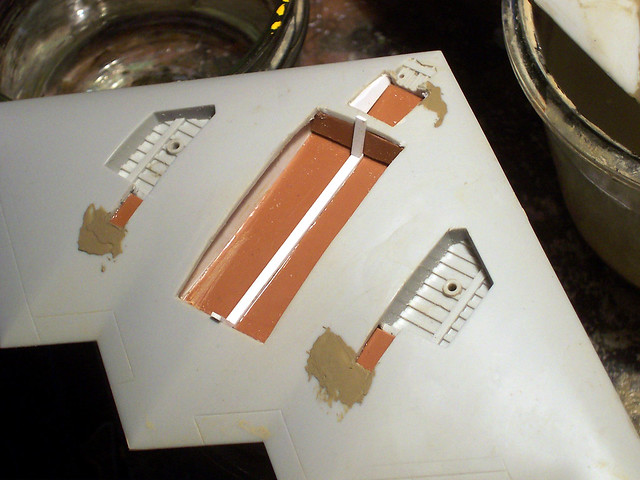
1:72 SAAB OAS 41 'Víðarr'; aircraft "23 Grey" of Skaraborgs Flygflottilj F 7, Swedish Air Force; Satenäs AB, 2014 (Whif/kit conversion) - WiP by
dizzyfugu, on Flickr
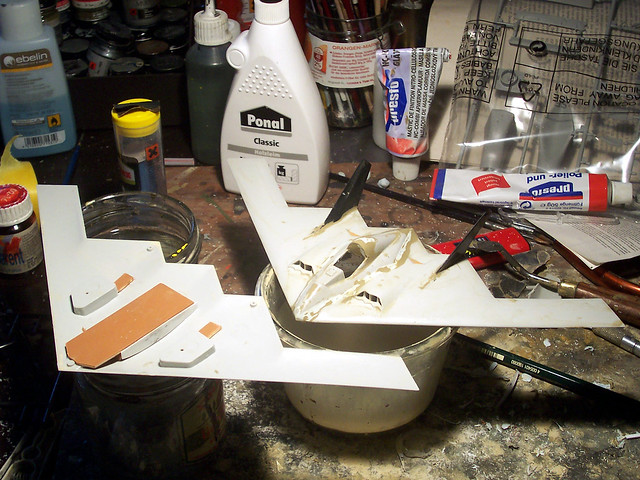
1:72 SAAB OAS 41 'Víðarr'; aircraft "23 Grey" of Skaraborgs Flygflottilj F 7, Swedish Air Force; Satenäs AB, 2014 (Whif/kit conversion) - WiP by
dizzyfugu, on Flickr
Der Anstrich ist inspiriert von norwegischen "Skjold Class" Küstenschutz-Schiffen - wenn auch farblich leicht verändert. Passt aber ganz gut, zumal ich etwas Spannenderes haben wollte als ödes Schwarz oder Grau-in-Grau.
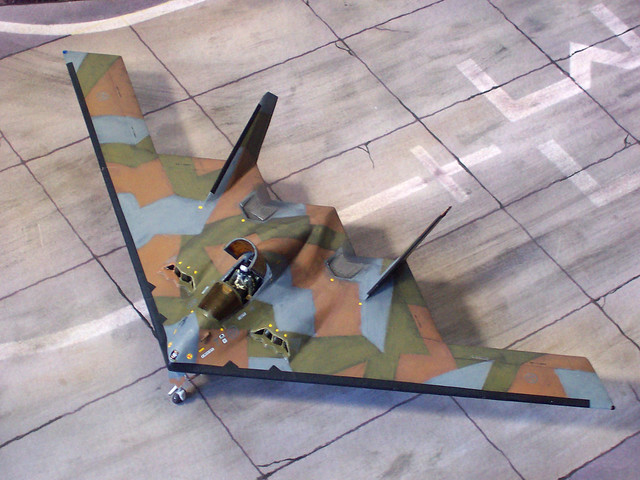
1:72 SAAB OAS 41 'Víðarr'; aircraft "23 Grey" of Skaraborgs Flygflottilj F 7, Swedish Air Force; Satenäs AB, 2014 (Whif/kit conversion) by
dizzyfugu, on Flickr
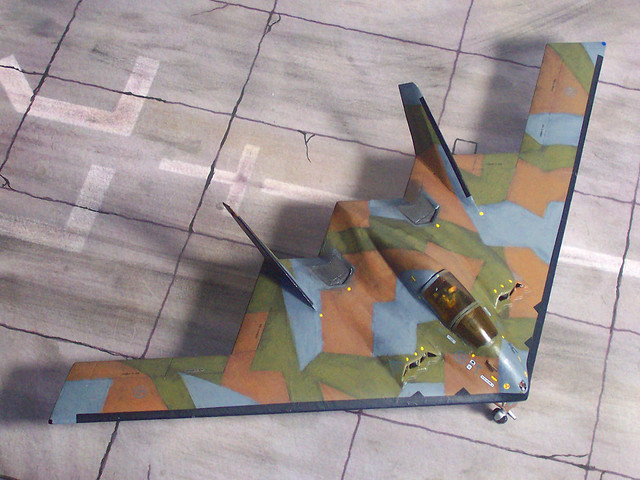
1:72 SAAB OAS 41 'Víðarr'; aircraft "23 Grey" of Skaraborgs Flygflottilj F 7, Swedish Air Force; Satenäs AB, 2014 (Whif/kit conversion) by
dizzyfugu, on Flickr

1:72 SAAB OAS 41 'Víðarr'; aircraft "23 Grey" of Skaraborgs Flygflottilj F 7, Swedish Air Force; Satenäs AB, 2014 (Whif/kit conversion) by
dizzyfugu, on Flickr